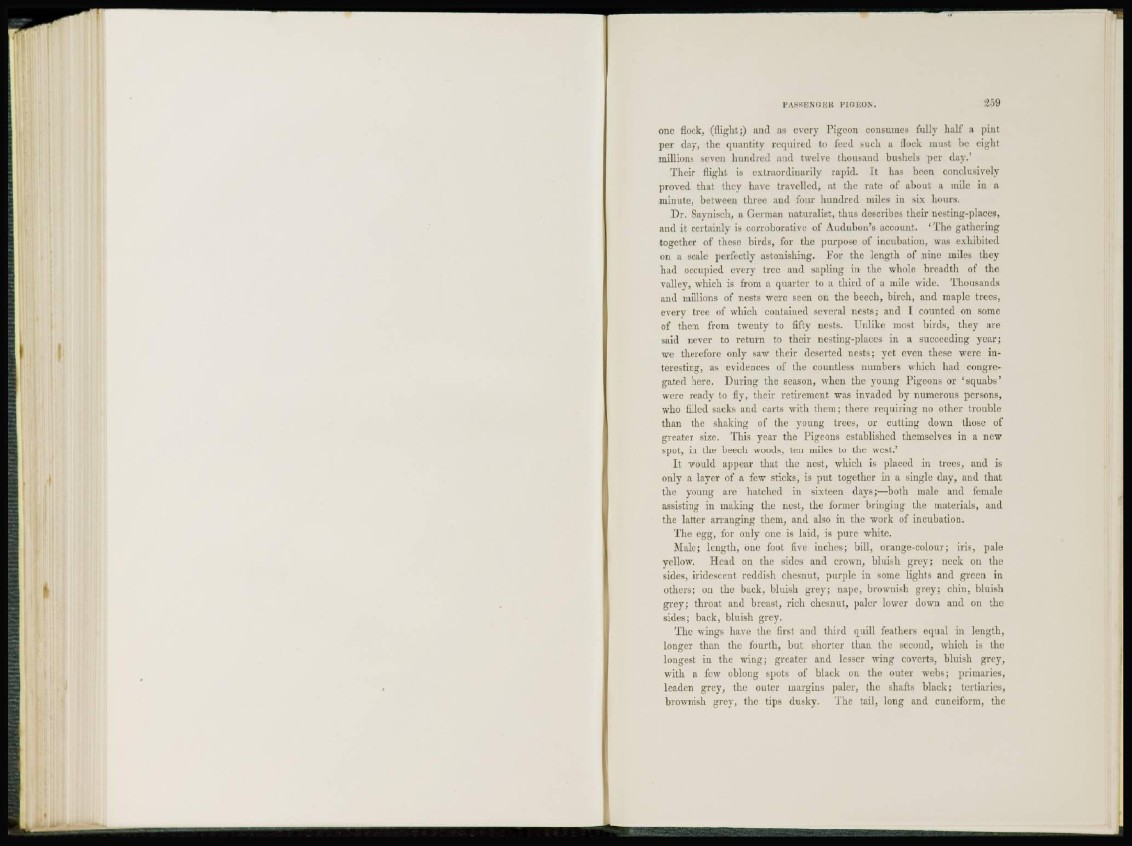
P A S S E N G KK P I G E O N. £59
one flock, (flight;) and as every Pigeon consumes fully half a pint
per day, the quantity required to feed such a flock must he eight
millions seven hundred and twelve thousand bushels per day.'
Their flight is extraordinarily rapid. It has been conclusively
proved that they have travelled, at the rate of about a mile in a
minute, between three and four hundred miles in six hours.
Dr. Saynisch, a German naturalist, thus describes their nesting-places,
and it certainly is corroborative of Audubon's account. 'The gathering
together of these birds, for the purpose of incubation, was exhibited
on a scale perfectly astonishing. For the length of nine miles they
had occupied every tree and sapling in the whole breadth of the
valley, which is from a quarter to a third of a mile wide. Thousands
and millions of nests were seen on the beech, birch, and maple trees,
every tree of which contained several nests; and I counted on some
of them from twenty to fifty nests. Unlike most birds, they are
said never to return to their nesting-places in a succeeding year;
we therefore only saw their deserted nests; yet even these were interesting,
as evidences of the countless numbers which had congregated
here. During the season, when the young Pigeons or ' s q u a b s'
were ready to fly, their retirement was invaded by numerous persons,
who filled sacks and carts with them; there requiring no other trouble
than the shaking of the young trees, or cutting down those of
greater size. This year the Pigeons established themselves in a new
spot, in the beech woods, ten miles to the west.'
I t would appear that the nest, which is placed in trees, and is
only a layer of a few sticks, is put together in a single day, and that
the young are hatched in sixteen days;—both male and female
assisting in making the nest, the former bringing the materials, and
the latter arranging them, and also in the work of incubation.
The egg, for only one is laid, is pure white.
Male; length, one foot five inches; bill, orange-colour; iris, pale
yellow. Head on the sides and crown, bluish grey; neck on the
sides, iridescent reddish chesnut, purple in some lights and green in
others; on the back, bluish grey; nape, brownish grey; chin, bluish
grey; throat and breast, rich chesnut, paler lower down and on the
sides; back, bluish grey.
The wings have the first and third quill feathers equal in length,
longer than the fourth, but shorter than the second, which is the
longest in the wing; greater and lesser wing coverts, bluish grey,
with a few oblong spots of black on the outer webs; primaries,
leaden grey, the outer margins paler, the shafts black; tertiaries,
brownish grey, the tips dusky. The tail, long and cuneiform, the